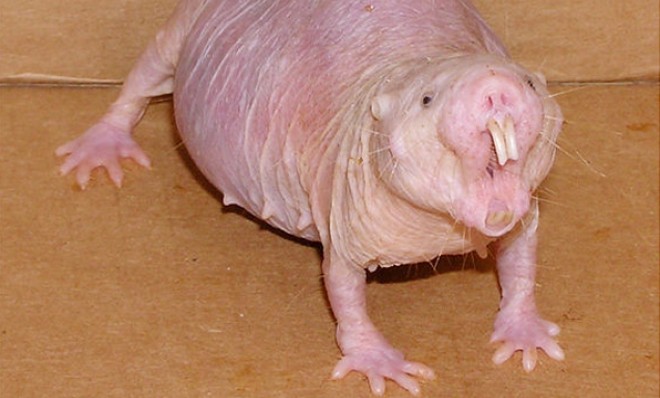5 animals that may hold the key to immortality
We could learn a lot from the naked mole rat

While death's cold, bony fingers will inevitably reach all creatures, Mother Nature has imbued a few of her quirkier children with resilient biology seemingly predisposed to keep mortality at bay. Tapping into their secrets has long been a quest for scientists, not least because the thought of our minds flickering out one day continues to bother most people. Here, in no particular order, are five animals who may just hold to clues to unlocking everlasting life:
1. The naked mole rat
Biologists love the subterranean rodent, and not for its handsome face — with its stretchy skin, wispy hairs, and squinty eyes bordering on blindness, the naked mole rat isn't much to look at. But the peculiar animals are incredibly resistant to disease and can live for well over 30 years, a ten-fold increase from other rodents.
The Week
Escape your echo chamber. Get the facts behind the news, plus analysis from multiple perspectives.

Sign up for The Week's Free Newsletters
From our morning news briefing to a weekly Good News Newsletter, get the best of The Week delivered directly to your inbox.
From our morning news briefing to a weekly Good News Newsletter, get the best of The Week delivered directly to your inbox.
A study published this week in the journal Proceeding of the National Academy of Sciences found that a chemical inside the mole rat's RNA gives its cellular protein factories "the kind of precision that would be the envy of German automotive engineers," says Geoffrey Mohan at the Los Angeles Times. That means their cells are less prone to errors as they get older, making mole rats far less susceptible to age-related diseases like cancer and Alzheimer's. God loves ugly, indeed.
2. Giant tortoises
Tortoises like to take it slow — so slow that it takes them forever to die. Carbon dating found that one giant Aldabra tortoise named Adwaita was around 225 years old when he died in 2006. And while not all tortoises are fortuitous enough to have been alive during the Declaration of Independence, something in the reptiles' genetic code appears to make them impervious to Death by Old.
The term for this rare ability is negligible senescence. According to io9, the "gradual accumulation of cellular damage and degradation that will eventually kill other animals (including us) slows to a virtual standstill, prolonging the life — and, in fact, the youth — of any animal lucky enough [to have it.]"
A free daily email with the biggest news stories of the day – and the best features from TheWeek.com
"In theory, if mortality rates did not increase as usual during aging, humans would live hundreds of years," says biologist Caleb Finch. From an evolutionary standpoint, some scientists think negligible senescence evolved to ensure the survival of slow-reproducing species, giving them a much wider window to, well, get it on.
3. Flatworms
Decapitating a human will usually kill them. Decapitating a flatworm, on the other hand, might just make more. In what sounds like the stuff of nightmares, scientists at Nottingham University in the U.K. managed to create an entire colony of more than 20,000 wiggly planarians by chopping a single original into several pieces, and letting them regenerate. (Just think about that for a sec.)
Scientists are just beginning to suspect that the creature's unparalleled healing factor — which allows them to grow new muscles, skin, guts, and even brains — could be due to the worms' ability to "renew stocks of a key enzyme," the Telegraph reports. Asexuality appears to have its perks.
4. Lobsters
Like tortoises, the shellfish are negligibly senescent. But unlike Earth's other creatures, they grow more fertile with age.
Lobsters continue to grow in size, too: A select group of lobsters produce a remarkable amount of telomerase, an enzyme that helps them grow new, larger shells throughout their lifetime, even as they approach 50 or 60.
Like the other aforementioned creatures, scientists think understanding why their cells are resistant to the rigors of age could help us develop cures for cancer and other ailments plaguing the elderly.
5. Jellyfish
Small enough to fit in a petri dish, Turritopsis dohrnii is often called "the Benjamin Button jellyfish." Observers have pointed out that, when captive, not only does the tiny organism refuse to die, but appears to grow younger and younger, until it reaches its earliest stage of development. Then, it does something truly miraculous: It starts its life over again.
-
 What will the US economy look like in 2026?
What will the US economy look like in 2026?Today’s Big Question Wall Street is bullish, but uncertain
-
 Alaa Abd el-Fattah: should Egyptian dissident be stripped of UK citizenship?
Alaa Abd el-Fattah: should Egyptian dissident be stripped of UK citizenship?Today's Big Question Resurfaced social media posts appear to show the democracy activist calling for the killing of Zionists and police
-
 Biggest political break-ups and make-ups of 2025
Biggest political break-ups and make-ups of 2025The Explainer From Trump and Musk to the UK and the EU, Christmas wouldn’t be Christmas without a round-up of the year’s relationship drama